
Easy (and fun!) ways to read more books
While we all know the benefits of reading, the reality is that life gets hectic. There’s a reason “read more” is such a common New Year’s resolution. As work piles on top of chores and social and family responsibilities, reading for pleasure can often take a backseat. When I was an English major in college, I happily read two books a week, but when I was at my first full-time job, I was lucky if I was able to read two books a year. It was only once I realized how much I missed being engrossed in a juicy page-turner that I decided to readjust my approach and learn how to read more without taking time away from other important activities.
We talked to big-time book lovers—book reviewers, librarians, book influencers on social media and Reader’s Digest Book Club members—to gather their tried-and-true tips for reading more books. From finding the best books for your taste and schedule to selecting shorter books for your limited attention span, this attainable, sustainable and judgment-free advice will get you to read every day.
Join the free Reader’s Digest Book Club for great reads, monthly discussions, author Q&As and a community of book lovers.

Remind yourself why you enjoy reading
Maybe you want to learn how to read more because you like escaping from reality into science fiction stories or fantasy books. Maybe fluffy romance novels warm your heart. The psychological trick to actually achieving your goals is to reflect on why you want to achieve that goal. And by consistently reminding yourself how good reading books makes you feel, you’re more likely to actually do it.
Tips from bookworms
BookTokker Nathan Shuherk of @schizophrenicreads feels healthiest when he reads for a few hours a day. “Especially in the years since my schizophrenia diagnosis, reading provides me with a solitary hobby that lets my brain explore ideas that keep me grounded in reality while [giving me the] ability to organize my chaotic mind,” he says.
Meanwhile, BookTokker Carmen Alvarez of @tomesandtextiles finds motivation to read in seeing people like her represented as the heroes of the story. “Currently, what keeps me interested and voraciously reading is the amount of diversity and representation in books,” she says. “It’s so wonderful to see multiple aspects of my identity reflected back to me in the pages of books, something I never would have imagined as a child.”

Regard reading as a treat, not a chore
Sometimes, reading can feel like yet another task on your growing to-do list, and as a result, you may be tempted to procrastinate about it. Rather than something you have to do, think of reading as a wonderful hobby that you want to do. By focusing on your love for reading and the benefits of reading, you can take active steps to prioritize it above other pursuits.
Tip from a bookworm
As an editor for Oh Reader magazine (a magazine dedicated entirely to the art of reading!), Gemma Peckham reads all day for work, so reading for pleasure can be challenging. After all, she says, “Netflix is always calling!” To remedy that, Peckham began adding reading time to her schedule.
“I realized that when we say we don’t have time to read, what we really mean is that we’re not prioritizing reading,” she says “Allot time in your calendar for reading—an hour between work and dinner or half an hour when you wake up. Treat it like a standing engagement that you can’t miss, and you’ll soon be looking forward to that regular ‘me time.'”
For example, I often reward myself after a long day by reading while taking a bubble bath, or after a long week by taking myself on solo coffee shop date with a good romance book!
And if you’re really struggling to resist the siren song of your favorite streaming platform, try to make an effort to read the book before you press play on its film adaptation.

Join a community of bookworms
Just as enlisting a running buddy will keep you committed to exercising, finding a community of bookworms and gleefully nerding out together will keep you engaged and inspired to read more books. Oh Reader magazine is essentially a love letter to reading and is filled with insightful stories that will have you itching to curl up next to a fireplace with a hot chocolate and a good book.
If you love discussing books with like-minded readers, you can sign up for online book clubs. Or if you’d rather meet in person, don’t be afraid to start a book club in your community. Having a dedicated space to celebrate reading is a great way to motivate yourself to explore new books and actually finish them.
Tip from a bookworm
Reading is a pretty solitary activity, but it doesn’t have to be something you do entirely on your own, says Tracey Neithercott, Reader’s Digest Books Editor and founder of the Reader’s Digest Book Club. “Sure, I read by myself, but what really gets me excited about a book is knowing I’ll be able to discuss it with others when I’m done,” she says. “When I can’t stop thinking about a fantastic book, I want to tell everyone I know about it. I want to check in and ask, ‘Did you get to the part where the guy does the thing?’ and ‘Am I the only one who despised the hero?’ Suddenly, reading is a community activity. And as a bonus, you get diverse perspectives and takes on a book.”
Another perk: Book clubs are a great solution for those who never know what to read next. “The group will regularly select something to read, but that’s just the premise of a book club,” says Neithercott. “Even better are the book recommendations you’ll get from the group. In the Reader’s Digest Book Club, members are constantly recommending the fantastic books they read outside the group. I have added so many great titles to my to-be-read list because of it!”
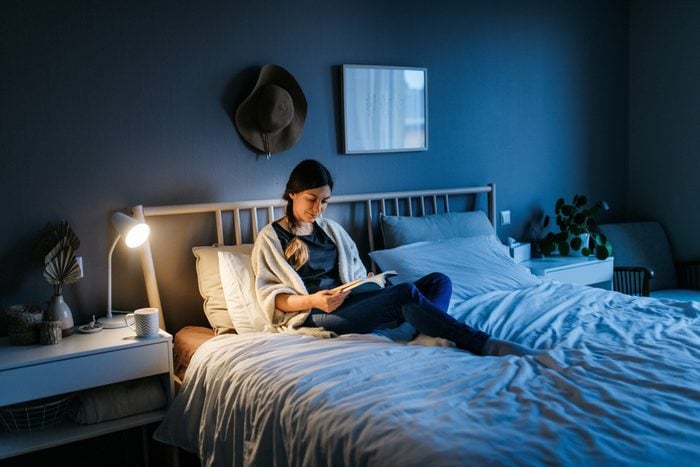
Read before bed
It’s tough to put down the phone after a long day—we get it. But looking through social media right before bed not only disrupts your sleep cycle, thanks to your phone’s blue light, but also makes you more likely to stay up late. These apps are literally designed to be addictive and keep you scrolling, leading to less sleep overall.
Instead, put a stack of books on your nightstand and replace screen time with reading a chapter or two every night. A book subscription box can help you build that TBR (to-be-read) pile.
Tip from a bookworm
“Reading in bed at night is like my treat for getting through the day,” says Peckham. “So I put my phone on the dresser on the other side of the room—which also helps me to get out of bed in the morning!—and get cozy with a book until I’m too sleepy to keep holding it up. This does mean that I usually have to reread the last few pages the next night because I was too sleep-addled to take them in!”
Looking for your next great book? Read four of today’s most compelling novels in the time it takes to read one with Fiction Favorites. And be sure to join the community!

Curate your social media feed by following book lovers
The social media addiction is a tough one to break, so rather than quitting cold turkey, try following BookTokkers (on TikTok) and Bookstagrammers (on Instagram) for inspiration and motivation for how to read more. Not only do these book influencers work super hard to create visually appealing literary content, but they also have tons of book recommendations and can help you discover stories you’d otherwise never hear about. Plus, their love for literature is absolutely infectious.
Tip from a bookworm
As someone in her 30s who doesn’t read YA books, I was nervous that BookTok and Bookstagram might only cater to Gen Z. However, I’ve found that there are influencers for every genre, age group and walk of life. Just go to the search feature on your preferred social media platform and type in your favorite book genre, and the world is your oyster! I’ve also started to follow my favorite local bookstores on Instagram, as bookstore owners and staff often post their personal reading picks and the hottest new books on their shelves.
Need help weeding through all the book recs? We think these BookTok books are totally worth the hype.

Get a library card
For many readers, the cost of books can be a barrier, and when you do buy a book, you may feel obligated to get your money’s worth and trudge through it even if you don’t like it. Luckily, borrowing both physical copies and e-books from your local library is completely free, and the due dates are a great motivator to finish a book (or accept that maybe that particular book is not the right fit for you).
Libraries are filled with pretty much every book genre under the sun and feature titles for both adults and children. And most carry audiobooks to boot!
Tips from bookworms
“If you love books or want to love books even more, there’s nothing better than a library card,” says Rosemary Kiladitis, children’s librarian at the Queens Public Library. “It’s your key to thousands of books to explore.”
Rakisha Kearns-White, senior YA librarian at the Brooklyn Public Library, agrees. “We are living in a golden age of access to books, where the most tentative reader can find a book to connect with. English language learners, neurodivergent students, visually impaired folks and children of all ages can utilize a variety of book formats,” she says. “Librarians aren’t gatekeepers to books and information, despite what a century of media stereotypes have taught us. We are the patron saints of putting reading materials in your hands.”

Stop worrying about “important” books
Adding classic books to your reading list is a wonderful goal, and reading the bestsellers everyone else is talking about can be exciting. But at the end of the day, if you’d like to read more, you should actually like what you read. Feel free to pick whatever genre you enjoy or topic that you want to explore!
Tips from bookworms
“It can be fun to read what’s popular and what book influencers like me are talking about, but when starting, make your reading deeply personal,” Shuherk advises.
Peckham echoes that sentiment. “Research books and authors, and find your own niche,” she says. “Read whatever you like—smut, fantasy, lit fic, sci-fi—without shame because if you love it, you won’t have to force yourself to read it. The best book in the world is the one you love most.”
If you’re having trouble finding a book that interests you, make another trip to your local library. “The library’s best asset is our staff, who can help readers find a book that will make them fall in love with reading,” says Lynn Lobash, associate director of reader services at the New York Public Library. “Tell them about a book you love or a genre or subject you want to explore, and you will not leave empty-handed!”

Don’t like the book? Don’t feel pressured to finish it
Get rid of that finish-what-you-started mentality, at least when it comes to reading. Not only will you be more likely to drag your feet when attempting to finish a book you don’t love, but doing so will also prevent you from spending your precious time reading something you’d actually enjoy.
Tips from bookworms
As the arts and culture editor of Mochi Magazine, Yvonne Su reviews many Asian American books and edits many book reviews. She’s well aware that readers’ tastes in books differ—and that’s perfectly fine! “I learned a lot from editing other readers’ [book] reviews: It’s OK to not like a book,” Su emphasizes.
Reader’s Digest Book Club member Kathryn Findlay Mayfield admits she hates to give up on a book. “Sometimes I pick it up again, and sometimes I don’t,” she says. “I might skim through a book that just doesn’t grab me, but my TBR list is very extensive, so there is always another choice.”

Read short story anthologies
There’s something about bite-sized narratives that feels less intimidating: If you don’t like one story, you can simply skip to another one. Since you don’t have to wade through pages and pages of filler when you read short stories, you’re also less likely to lose interest in the book.
Tip from a bookworm
Peckham advises always having a book of short stories when you’re on the go: “Sometimes I don’t feel like I have the bandwidth for a lengthy story—and there are oodles of amazing short story collections out there,” she says. Besides, there are short story collections for every genre, so you can pick your favorite type of short stories and know that you’ll actually enjoy them.
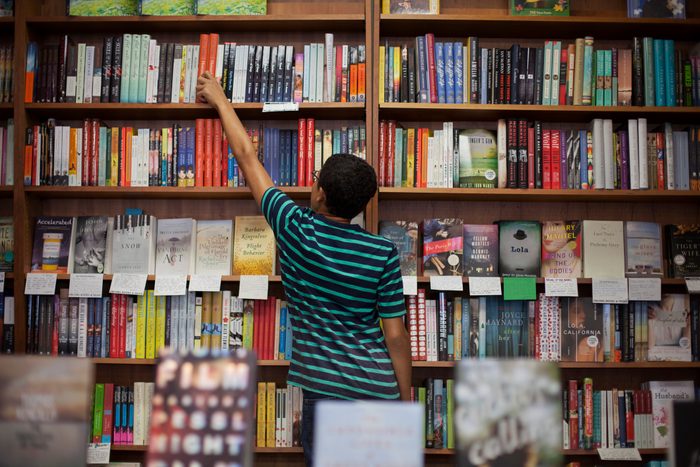
Try different kinds of books
While fiction and nonfiction books are the usual go-tos for readers, other storytelling formats can be just as impactful and help you read more books.
Tip from a bookworm
“Nonfiction graphic novels are making the most difficult material easy to digest,” says Kearns-White. No longer just for children, graphic novels are gaining more respect in the literary world, with adult graphic memoirs like Marjane Satrapi’s Persepolis paving the way. They’re quick to read and accessible while still delivering compelling stories.
Personally, when I have only a few minutes—and mental bandwidth—to spare, I like to turn to poetry books. A single line of poetry can evoke an entire narrative, and it’s enough to keep your brain stimulated all day. Some readers may feel like poetry is “not for them” if they’re not a fan of extended metaphors and ambiguous symbolism. But types of poems vary widely, and there’s something out there for everyone!

Strategically place books around the house
Always having a book within reach will keep you from reaching for your phone out of boredom, so leave different books around your house or apartment. Whether they’re gorgeous coffee table books or fun books near your toilet (we won’t judge), you’re more likely to read more when you surround yourself with books.
As an added bonus, those colorful spines add a decorative flair to your interior design (no matter how you organize your books), and they provide conversation starters for guests.
Tip from a bookworm
“I keep a book in the car, a book by my bed and a book in the bathroom,” Reader’s Digest Book Club member Ellen Smith shares. “I also have the Kindle app on my phone. I typically read at bedtime, but if I get stuck somewhere and have to wait, or have time for a bubble bath, I’m all set.”

Carry a book everywhere
If you’re out and about, always carry a book in your bag. Whether you prefer physical books or e-readers (or even your phone!), having something to read is a healthy way to pass the time while still engaging your brain.
Tip from a bookworm
I used to dread my daily train commute to the office until I realized that was valuable 45-minute reading time. Not only did leaving my phone in my bag ensure I was establishing healthy boundaries by not answering emails outside of office hours, but having fun reading during that time made the commute go by so much faster. Just make sure to pay attention to the train or bus stations so you don’t get so engrossed in that thriller book that you miss your stop! Similarly, time flies when you have a book while sitting in the waiting room at the doctor’s office or waiting in line at the DMV.
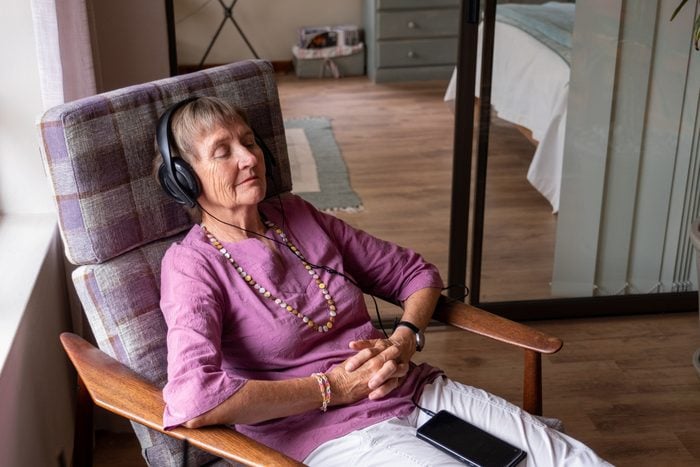
Don’t shy away from audiobooks
This is the PSA you needed to hear: Audiobooks are not cheating! They make it easy to read a book while driving, doing dishes, exercising or even commuting to class or work if you’re prone to motion sickness and can’t look at a physical copy.
Tips from bookworms
“When I’m on a deadline for a review or interview [for my BookTok], not only do I read the physical or e-book, but I also try to have a copy of the audiobook so that I can listen to the audiobook when I can’t physically read the book,” says Alvarez. “This helps double the amount of reading I can get done in a busy day.”
And audiobooks are not just sold on Spotify or Amazon (though you can certainly get them there). There are plenty of places where audiobooks are available for free, such as the library. “Downloadable e-books and e-audiobooks can be accessed with a few taps from a mobile phone or tablet,” Kearns-White says. “Besides the good ol’ paperback novel, my favorite format is our read-along books, which have technology embedded in the pages, allowing the book to read to you. A library user can plug in a pair of headphones and get lost in a story while learning to read in English.”

Be open to reading multiple books at once
Maybe that award-winning memoir you’re struggling to finish is brilliant but emotionally draining. Or maybe you like reading at night but are afraid horror books are going to be nightmare fuel. You may need a lighthearted feel-good book to balance out the deeper, darker titles. By switching between books, you’re being mindful and respectful of your brain’s current state, and you’re going to appreciate each of those books for their unique qualities so much more.
Tips from bookworms
“I read one book before falling asleep that doesn’t scare me, like a cozy mystery or romance, [and] a different kind of book for daytime reading,” says Reader’s Digest Book Club member Melissa Stephens.
If you’re nervous about getting overwhelmed and never finishing the books, book clubber Carrie Myers recommends having different forms of reading for each book. “Listen to audiobooks in the car or on a walk, read an e-book while at the gym on the treadmill or elliptical, and have a physical book to read at home,” she says. “Three books at once!”

Read or listen to author interviews
These days, most authors have interviews as part of their press cycles. (Case in point: Author Iris Yamashita’s interview with Reader’s Digest about her debut novel.) And those articles or podcasts are inspirational gems. You’ll get insight into their most recent book and a peek behind the curtain of the world of literature.
Tip from a bookworm
“Writing for Mochi mag gave me the chance to interview authors, and talking to them demystified what it meant to write a book,” Su says. “Authors are people who love books, have a story to tell and have managed to get those stories out to us.”
Besides, interviewers typically ask authors about their favorite or current reads, and they usually have fantastic book recommendations. You’re bound to like your favorite author’s favorite authors.
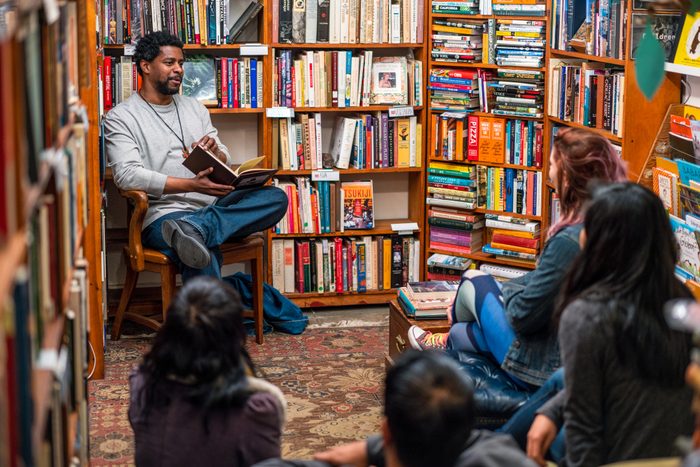
Attend book readings
If you have access to a bigger metropolitan library or popular bookstore, you’re in luck. You should be able to find in-person book readings near you where authors read excerpts from their books, discuss their inspirations and thought processes, and answer questions from the audience.
Tip from a bookworm
Movie and concert tickets cost money, but as New York Public Library reader services librarian Heather Barnum says, you can “enjoy an author talk” for free. So when I’m feeling cooped up at home but don’t want to break the bank, I go to my local bookstore’s website and peruse their events calendar.
Don’t worry about whether you’ve read the book or heard of the author either. You can get a little preview of the books from the authors themselves, which is more likely to pique your interest and get you to read the whole story. You can even meet a lot of fellow book lovers and build beautiful literary friendships.

Keep track of every book you read
While it can be daunting to set a specific goal for the number of books you want to read, it is motivating in and of itself to record every book you read and celebrate those accomplishments. You can use an app, or go analog and use a book-tracking journal to write down (and maybe even write about) the books you’re currently reading or just finished reading.
Tip from a bookworm
When I wanted to learn how to read more, the biggest game changer for me was creating a Goodreads account. Not only was it free and easy to set up, but I felt super proud to move books from my “Currently Reading” list to my “Read” list. You can even scan books to add to your “Want to Read” list, follow your bookworm friends on Goodreads and refer to your reading history when your friends ask for recommendations.

Don’t be afraid to take breaks from reading
It sounds counterintuitive, but taking breaks is crucial to both maintaining your mental health and keeping your goal to read more books sustainable. Maybe you read an especially dense, emotionally heavy or sad book and you need some time to let it sink in. Maybe you just need to give your brain a break so you can come back to your next book feeling refreshed.
Tips from bookworms
“If you need a break for a day or a week, take it,” Shuherk reminds fellow readers. “Goals are nice, but if they’re not flexible, you’re more likely to burn out and ruin what’s supposed to be a fun, healthy hobby. It’s not a competition—or at least, it shouldn’t be.”
Su agrees. “It’s OK to go weeks or even months without finishing a book,” she says. “Reading slumps are real, and sometimes it takes one special book, like an old favorite, a graphic novel or a memoir for me, to get back into the groove of reading.”
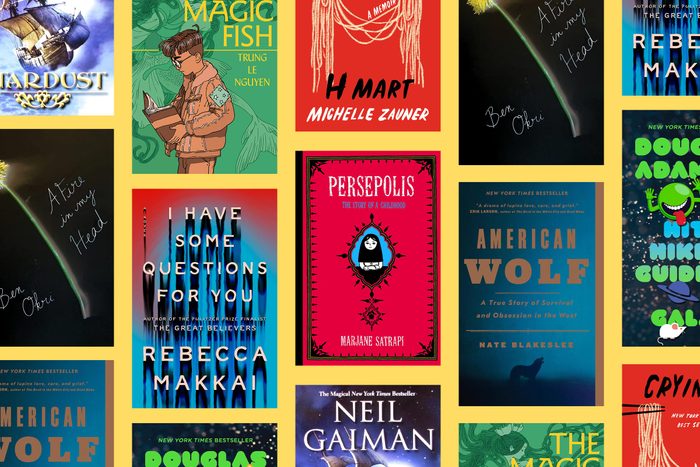
FAQs
Why should you read more books?
Many adults lament the fact that although they spent their childhood with their noses stuck in a book, that hasn’t been the case for a very long time. And that’s a shame: Reading a lot is tied to higher literacy skills in kids, but it’s also linked in adults to better mental health, expanded emotional intelligence, an improved vocabulary and a reduced risk of cognitive decay.
In other words, books inspire us and make us more empathetic, smarter and healthier. For this reason, reading more books is important. But it’s also noteworthy that reading more isn’t just tied to a specific number of books. Many of the book experts we spoke to about learning how to read more stressed that it’s not necessarily about quantity but quality.
At the end of the day, when you read more than the average American, you’ll feel happier than doomscrolling through social media. So give your eyes a break with screen-free time and crack open that book!
What books should I start with?
Now that you have all these tips from expert readers on how to read more books, the question is where to start. We’re including some of our favorite books to help you meet your goal of reading more. Get ready for the biggest book hangover of your life.
- American Wolf: A True Story of Survival and Obsession in the West by Nate Blakeslee
- Stardust by Neil Gaiman
- The Hitchhiker’s Guide to the Galaxy by Douglas Adams (and the rest of the book series!)
- Persepolis by Marjane Satrapi
- I Have Some Questions for You by Rebecca Makkai
- Crying in H Mart by Michelle Zauner
- The Magic Fish by Trung Le Nguyen
- A Fire in My Head: Poems for the Dawn by Ben Okri
Get Reader’s Digest’s Read Up newsletter for more books, humor, travel, tech and fun facts all week long.
About the experts
|
Why trust us
At Reader’s Digest, we’ve been sharing our favorite books for over 100 years. We’ve worked with bestselling authors including Susan Orlean, Janet Evanovich and Alex Haley, whose Pulitzer Prize–winning Roots grew out of a project funded by and originally published in the magazine. Through Fiction Favorites (formerly Select Editions and Condensed Books), Reader’s Digest has been publishing anthologies of abridged novels for decades. We’ve worked with some of the biggest names in fiction, including James Patterson, Ruth Ware, Kristin Hannah and more. The Reader’s Digest Book Club, helmed by Books Editor Tracey Neithercott, introduces readers to even more of today’s best fiction by upcoming, bestselling and award-winning authors. For this piece on how to read more, Sarah Jinee Park tapped her experience as a journalist who writes about books for Reader’s Digest to ensure that all information is accurate and offers the best possible advice to readers. We verify all facts and data, back them with credible sourcing and revisit them over time to ensure they remain accurate and up to date. Read more about our team, our contributors and our editorial policies.
Sources:
- Nathan Shuherk, BookTokker who goes by @schizophrenicreads
- Carmen Alvarez, BookTokker who goes by @tomesandtextiles
- Gemma Peckham, editor for Oh Reader
- Rosemary Kiladitis, children’s librarian at Queens Public Library
- Rakisha Kearns-White, senior YA librarian at Brooklyn Public Library
- Lynn Lobash, associate director of reader services at New York Public Library
- Yvonne Su, arts and culture editor of Mochi Magazine
- Heather Barnum, reader services librarian at New York Public Library
- Neurology: “Life-span cognitive activity, neuropathologic burden, and cognitive aging”
